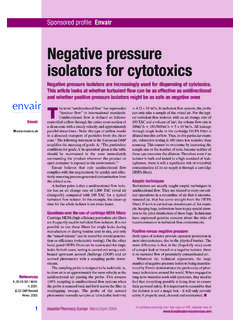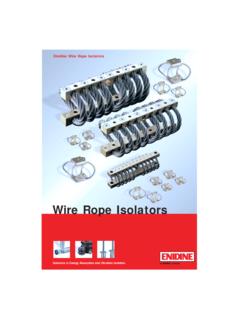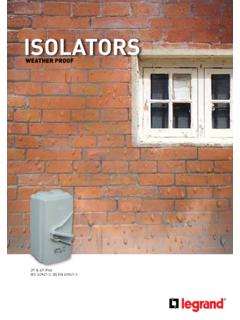Transcription of The Care and Feeding of the R.F. Isolator - EMR Corp
1 1 The care and Feeding of the IsolatorBy:William F. Lieske, , EMR CorporationIntroductionOver the past thirty years or more the numberof receivers and transmitters at establishedwireless system repeater sites has increasedmany times over. The number of antennasfound on towers and building tops has alsoincreased despite the application of transmittercombining and receiver the conversion from analog to digitalmodulation methods takes place, the effectsof interference to signal reception as the resultof mixing of both digital and analog transmittersignals in power amplifier stages becomeseven more of a problem than in the application of suitable isolators withcomplementary filtering devices now becomeseven more important as this change intechnology purpose of this bulletin is to review thecharacteristics of isolators and theiroperation and discuss the ways in which thesedevices are applied to control interference dueto intermodulation products and to provideother benefits.
2 A better understanding of , their benefits, limitations and shortcomings and the best ways to employ themwill be covered in this Are isolators ?These devices have been used in land mobile(wireless) systems for more than threedecades. The need for them has increasedalmost exponentially as complex, multichannelsystems have developed, particularly duringthe past fifteen years. The availability ofsuitable locations for the operation of suchsystems is limited by geographiccharacteristics in most areas, leading to theclustering of up to hundreds of transmitter-receiver combinations at a common transmitting power amplifiers in usetoday are solid state types, using powertransistors or power FET components. Theneed for a high order of operating efficiencydetermines that these components areoperated in Class C mode.
3 This results in anon-linear condition in which signals from oneor more nearby transmitters can be coupledinto a given and mix with the desiredsignal to produce unwanted spurious unwanted signals can result from theproducts generated through mixing thefundamental signal frequencies and/or thevarious harmonics of the constituents too often, the unwanted signals fall on ornear receiving channels at the operating siteand are of sufficient strength to causedestructive interference to the conduct ofnormal and desired reception of voice anddata. This phenomenon of this signal mixingis called intermodulation or interference. isolators are one of the keycomponents used to help control this form with cavity resonators, harmonic or lowpass filters, isolators provide a solution tointerference problems that would otherwisedestroy effective communications.
4 Isolatorshave become an important tool for use inmodern wireless system site managementand interference control care and Feeding of the IsolatorIsolators: What they are, how they workThe basic Isolator is made from a devicecalled a circulator with a matched loadtermination (See Figure 1). The circulatorconsists of ferrite materials, magnets,inductors and capacitors according to theband of operation, input power rating, andintended best designs include sturdy plated steelcases that provide high immunity to outsidemagnetic influences. Careful thermalcompensation is used to limit drift under highoperating duty cycles and high ambienttemperatures. The load termination is typicallya beryllium rod or rectangular body on whichcarbon has been applied in a special mannerwith suitable contacts to form a powerdissipating resistor.
5 This element is enclosedin a suitable load body made from copper,aluminum or brass and equipped with heatsink fins to aid in dissipating combination of a circulator and a loadtermination becomes a device that power in a forward direction from atransmitter s output to an antenna feed linewith very low loss of power due to signal that is reflected from theantenna system due to mismatch or de-tuning or coupled into the antenna fromadjacent transmitting antennas will see ahigh loss path toward the transmitter but a lowloss path toward the load termination (SeeFigure 2).Ferrite discs Junction(Center Conductor)123 MagnetsInputPortOutput PortLoadPortLow loss indirection of arrow, high loss in reversedirection Lump Constant Circulator ArrangementFigure 2(1) Conversion loss is the difference between the lesser strength of twosignals as mixed together and the relative strength of the resultingheterodyne product(s).
6 Reflected power is prevented from reachingthe transmitter power amplifier stage where itcould impair the performance of the amplifierstage. In case of a coupled signal, mixing inthe stage is controlled to reduce oreliminate signals known as intermodulation or Intermodulation products are generated whentwo or more signals are mixed together in anyelectrically non-linear device (such as a diode).Most modern solid state power amplifiersemploy transistors or power FET s operatedin class B or C mode for the sake ofelectrical efficiency. They are found to beeffective signal mixers, often exhibiting lessthan 10 dB mixing conversion loss.(1)Isolation between the system antenna and apower amplifier may be provided by a singlestage Isolator . This is found to be at least 20dB and often higher than 30 dB in higher gradeisolators.
7 isolators may be cascaded to secureneeded system isolations and both theinsertion loss and isolation properties of theindividual units are additive. Dual and triplesection isolators are found in today s market,Circulator LoadTermination+Input PortOutput PortLoad PortIsolatorFigure 1 Lump ConstantCirculator Arrangement3 The care and Feeding of the Isolatorproviding as much as 100 dB of insertion loss is under dB and canbe as low as dB per junction in high and Isolator TypesThere are two types of circulators in currentusage: Distributed Constant (sometimescalled distributive constant) and LumpedConstant. The difference in these types isfound in the coupling method used to applyand recover energy from the the distributed constant type, two relativelylarge planes of ferrite material are arrangedeither as thin triangles, discs or hexagonalshapes.
8 A conductor having three arms isinterposed between these ferrite bodies. Thiselement, referred to as a center conductor or junction , connects to terminals, typicallycoaxial concentrate magnetic flux through theassembly, magnetically biasing the assembly is then placed in an enclosurewith three coaxial connectors, becoming asingle junction circulator. Two junctionassemblies are arranged in a single case toform a dual unit and three assemblies for atriple unit. There are significant savings inmaterials and the performance is better inmulti-junction units compared with having twoor three single units tied together with cablesor of an EMR Corp. medium power dualisolator are shown in Figure 4. This same styleis used for up to 150 watt transmitter powerinputs in bands from 66 through GHz.
9 Theunit shown has a 30 watt load termination atthe input section and a 60 watt termination atthe output section. Load termination ratingswill be discussed further, later in the R. F. IsolatorInputOutputLoad #1 Load #2 Model:Freq: Series R. F. IsolatorModel 8350/34, 66-108 8450/34, 118-225 8550/34, 406-520 8650/34, 806-960 8750/34, 1630 Load TerminationModel 1640 Load Termination8650 Power IsolatorsTwo hundred fifty watt rated single and dualjunction isolators are provided for frequencyranges from 72 through 960 MHz. EMR single junction 500 watt continuousduty rated units for 88-108 (FM Broadcast) andhigh power paging application on the 150-174,450-470 and 928-932 MHz seen in Figure 3, flat magnets, changedand polarized as shown, are arranged withmild steel ground planes and pole pieces Figure 4 Upper MagnetUpper Magnet Pole PieceUpper MagnetGround Plane"Y" JunctionCenter ConductorFerrite GarnetDiscs or TrianglesLower Pole PieceLower MagnetGround PlaneLower Magnet Magnetic FluxOrientationNorth PoleSee text for explanations of elements and their circuit 3 See text for explanations of elements and their circuit care and Feeding of the Isolator Development work on 1,000 watt and higherpower isolators is being continued currently(January, 1999).
10 System ApplicationsWireless land mobile communications siteshave been established on literally everyavailable high building, hill top or mountain topas well as on towers erected for the are many other desirable locations thatcould serve as remote sites, however,government and private ownership tends tolimit this usage mainly due to the general public, business andgovernment wants and needs the benefits oflong range wireless communications, towersand antennas are considered ugly to manyenvironmentalists. This has contributed tosevere over population of existing sites withnew equipment, operating on new frequenciesand new antennas. With less than adequateavailability of channels within popular landmobile bands, every conceivable combinationof frequencies and system types might befound at any given without the application of proper siteplanning, some kind of interference isexperienced.






